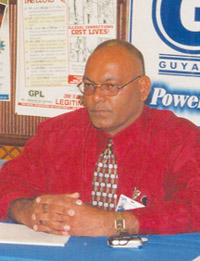While the contractor for the US$43 million Chinese-funded transmission and distribution upgrade project might be the same one that built the troubled Skeldon sugar factory, CEO of Guyana Power and Light (GPL) Bharat Dindyal says he is not worried that the work would not be done properly since supervisory measures are in place.
Speaking to Stabroek News last week, the CEO said the company that would be actually doing the work is a dedicated sub-contractor Jiangxi Thermal Power Construction Company (JTPCC).

The project also has a component which sees the laying of a fibre-optic cable to provide for information to flow from the substations to the power stations.
The company that won the bid as the contractor for the transmission and distribution network upgrade is China National Technical Import and Export Cooperation (CNTIC), but Dindyal said he was not absolutely sure that this is the same company that constructed the beleaguered Skeldon factory, even though the name seemed identical.
“There is a new contractor and a dedicated sub-contractor, [the latter of whom does the work], said Dindyal. The name of the contractor is the same but the sub-contractor is a different one,” Dindyal said.
He explained that the loan is a highly concessional one and the conditions of it stipulate that Chinese companies must be utilised for the project.
When asked how much of a concern is the fact that this might be the same contractor that worked on the ill-fated Skeldon plant, Dindyal said he cannot say that the problems with Skeldon are attributable to the contractor.
Further, he said that for the transmission and distribution works, GPL has contracted the services of two consulting companies that would be supervising.
A November 2010 Stabroek News editorial on the Skeldon project asked questions such as what penalties are ascribable to CNTIC for its failings and whether there have been any, whether the defects were remediable, whether it was a case of defective and cheap components fitted to the huge factory and whether CNTIC should be disengaged from the project.
The then president Bharrat Jagdeo warned in 2010 that the facility was not working anywhere near to its capacity and that he would get personally involved to see it remedied.
“This is a US$200 million facility… unfortunately, it’s not delivering the results we expected it to,” Jagdeo had said. “They have too many mistakes going on there and I intend to fix it… it has to change,” he said. “We’re not going to make that sort of investment to have a few people mess it up,” he also stated. “So even if it means personally I have to get involved, I will get involved to ensure that it is fixed… that it’s delivering the kind of results that it should deliver, so that we can safeguard the sugar industry.”
Several years ago, government dismissed the Booker-Tate management contending that the Guyana Sugar Corporation would be able to run the factory, but instead it has seen mounting defects. But in an admission last year, then minister of agriculture Robert Persaud said government may consider having foreign nationals manage the facility, which has been underperforming for a number of reasons. The factory has had several issues with a boiler which had to be put out of operation for a period of time.
The minister had at that time said that the performance of the sugar sector was contingent on Skeldon getting up to full production.
Work began on the factory in 2005 and it was expected that the project would have been completed by October 2007.
The commissioning date was pushed back several times and it was officially commissioned in August 2009.
CNTIC was engaged in a turn-key contract which would have seen GuySuCo take charge of its running. However, the decision to put construction in the hands of CNTIC had been severely criticised.




